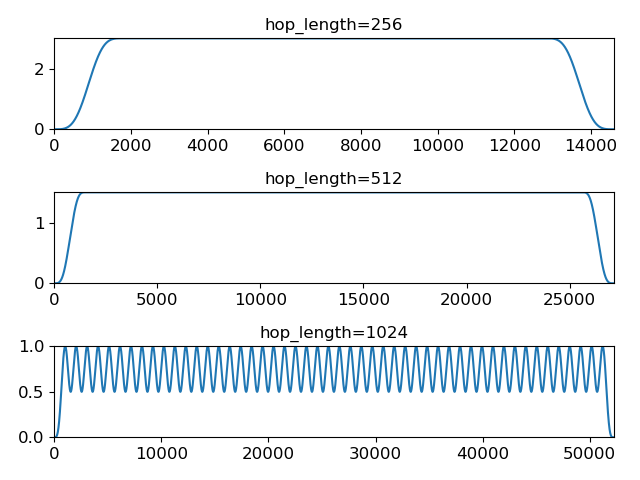Caution
You're reading an old version of this documentation. If you want up-to-date information, please have a look at 0.9.1.
librosa.filters.window_sumsquare¶
- librosa.filters.window_sumsquare(window, n_frames, hop_length=512, win_length=None, n_fft=2048, dtype=<class 'numpy.float32'>, norm=None)[source]¶
Compute the sum-square envelope of a window function at a given hop length.
This is used to estimate modulation effects induced by windowing observations in short-time fourier transforms.
- Parameters
- windowstring, tuple, number, callable, or list-like
Window specification, as in
get_window- n_framesint > 0
The number of analysis frames
- hop_lengthint > 0
The number of samples to advance between frames
- win_length[optional]
The length of the window function. By default, this matches n_fft.
- n_fftint > 0
The length of each analysis frame.
- dtypenp.dtype
The data type of the output
- Returns
- wssnp.ndarray, shape=`(n_fft + hop_length * (n_frames - 1))`
The sum-squared envelope of the window function
Examples
For a fixed frame length (2048), compare modulation effects for a Hann window at different hop lengths:
>>> n_frames = 50 >>> wss_256 = librosa.filters.window_sumsquare('hann', n_frames, hop_length=256) >>> wss_512 = librosa.filters.window_sumsquare('hann', n_frames, hop_length=512) >>> wss_1024 = librosa.filters.window_sumsquare('hann', n_frames, hop_length=1024)
>>> import matplotlib.pyplot as plt >>> plt.figure() >>> plt.subplot(3,1,1) >>> plt.plot(wss_256) >>> plt.title('hop_length=256') >>> plt.subplot(3,1,2) >>> plt.plot(wss_512) >>> plt.title('hop_length=512') >>> plt.subplot(3,1,3) >>> plt.plot(wss_1024) >>> plt.title('hop_length=1024') >>> plt.tight_layout() >>> plt.show()
